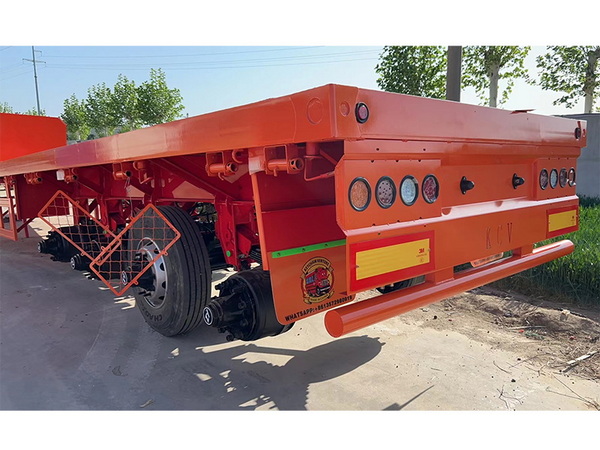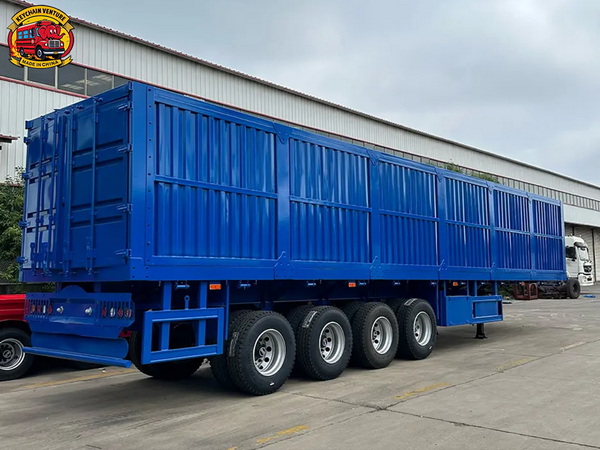Views: 222 Author: Amanda Publish Time: 2025-11-06 Origin: Site








Content Menu
● Typical Overall Lengths: A Broad Overview
● Regional and Regulatory Impacts on Usable Length
● Key Influences on Length Variability
● Operational Consequences: What Length Means in Practice
● Operational and Market Considerations for KeyChain Venture Co., Ltd.
● FAQ
>> 1. What is the typical length of a semi trailer in North America?
>> 2. How does trailer length affect payload capacity?
>> 3. What are extendable trailers and when are they used?
>> 4. Are there regional differences in maximum legal lengths?
>> 5. How do fleets manage longer combinations safely and legally?
Understanding the length of a semi trailer is more than a curiosity for fleet managers and logistics professionals; it underpins route feasibility, loading efficiency, regulatory compliance, and overall asset utilization. In the global freight ecosystem, the semi trailer serves as the backbone of door-to-door transport, bridging manufacturing hubs with distribution networks across cities and continents. This article delves into typical configurations, notable variations by trailer type, regional regulatory influences, and practical implications for operators who depend on predictable performance from their equipment. By examining standard lengths, extended/oversized options, and the operational trade-offs, readers will gain a grounded perspective on how best to select, pair, and deploy Semi Trailer configurations for maximum efficiency.

A semi trailer is a type of trailer that relies on a tractor unit for front-end support, transferring most of the vertical load to the tractor via the fifth wheel connection, while the trailer itself carries the cargo. The term “Semi Trailer” often appears alongside “tractor-trailer” or “semi-truck,” though precise vocabulary can vary by region. For fleet planning, the key distinction is that the overall length and maneuverability of the combination depend on both the tractor configuration and the trailer design. In practice, Semi Trailer configurations span a wide spectrum—from standard dry vans to flatbeds, reefers, tankers, and specialized extendable or lowboy models—each chosen to optimize payload density, loading methods, and route capabilities.
The length of a tractor-trailer combination is influenced by the type of trailer, the tractor's geometry, and the regulatory environment. While regional rules govern maximum permissible lengths, the practical, operational length readers encounter most often falls into several broad categories:
- Standard dry van combinations: The typical dry van trailer is 53 feet long, with an overall road-length commonly around 70–75 feet when paired with a standard tractor. This configuration represents the workhorse setup for many general freight needs, balancing payload capacity with predictable maneuverability.
- Refrigerated trailers (reefers): Similar in exterior length to dry vans, reefers are built with insulation and refrigeration equipment that may add weight but rarely change the exterior length significantly. Total operating length tends to align with standard 70–75 feet ranges.
- Flatbed trailers: Flatbeds frequently range from 40 to 53 feet in length, depending on the application. Heavier or longer loads might necessitate longer flatbeds or specialized extendable variants, slightly expanding total combination length in practice.
- Tanker trailers: Tankers commonly measure 40 to 53 feet, with length selected to balance capacity, safe loading dynamics, and road legal constraints. In some regions, tanker assemblies may increase total length due to additional equipment or insulation.
- Specialized trailers: Lowboy/lowbed, extendable/accordion trailers, removable goosenecks (RGN), and multi-axle configurations can extend well beyond standard lengths. For oversized or multi-vehicle shipments, total lengths can approach or exceed 80 feet, and in some cases surpass 100 feet when fully extended or configured for multi-vehicle transport.
- Intermodal containers: When combined with chassis, intermodal configurations typically bring 20- or 40-foot container lengths into play, with the overall combination length governed by the trailer type used to carry the load and the tractor's footprint.
Regulatory regimes shape the practical maximum length of a Semi Trailer combination. In North America, for instance, typical maximums for standard configurations are around 70–75 feet for the overall vehicle length, with state or provincial permits enabling longer combinations in particular corridors (such as double trailers or certain interstates). In many European countries, total lengths can be 16.5 meters (about 54 feet) for individual trailers, with combined allowances varying by country and road class. Asia-Pacific markets present their own sets of constraints, often reflecting a mix of national legislation and road network design. For fleets operating across borders, awareness of permit regimes, pilot-car requirements, and escort rules is essential to maintain legal operations while optimizing load factors.
Several practical factors determine whether a Semi Trailer configuration leans toward shorter or longer lengths:
- Cargo type and loading method: Hazardous materials, bulky machinery, or unusually shaped loads may require extended or specialized trailers to accommodate safe handling and securing practices.
- Dock and yard geometry: Fleet yards with tight turning radii or narrow loading bays favor shorter, more maneuverable configurations, while facilities designed for express intermodal can accommodate longer hulls.
- Weight distribution and axle configuration: Heavier payloads often necessitate additional axles and spacing that influence overall length and balance, especially in regimes with axle-weight limits.
- Handling and safety considerations: Longer trailers demand longer braking distances, greater awareness for following vehicles, and enhanced signaling for lane changes and merges.
- Intermodal and multi-modal needs: When shipments involve transfers between rail and road, trailer length interacts with container sizes, chassis availability, and terminal workflows.

- Fleet productivity and utilization: A mix of standard 53-foot dry vans, reefers, and flatbeds can optimize asset usage, while occasional extended or specialized trailers unlock capacities for oversized goods. Careful planning reduces downtime spent on loading, unloading, and repositioning equipment.
- Route planning and permits: Longer combinations may require route planning with awareness of bridge heights, lane widths, and permit stipulations. Pilot vehicles and escort arrangements might be necessary for certain corridors, adding to trip costs but enabling legitimate transport of oversized loads.
- Safety and compliance: An understanding of length translates into safer braking, turn planning, and lane discipline. Operators must ensure compliance with traffic laws and the trailer's dynamic footprint to minimize risk on congested highways.
- Loading efficiency: Dock configurations—loading docks, overhead doors, and ramp angles—play a significant role in determining which trailer type is most efficient for a given operation. Designing yard flows around typical trailer lengths can reduce handling time and drive up throughput.
As a leading Chinese supplier of premium commercial vehicles, KeyChain Venture Co., Ltd. has a strategic interest in articulating the role of Semi Trailer configurations for both domestic and international markets. This piece can emphasize:
- The breadth of Semi Trailer types available to meet diverse customer needs, from standard dry vans to specialized extendable and RO-NG configurations.
- How modular design and high-strength materials support payload optimization, durability, and safety in demanding freight scenarios.
- The importance of regulatory literacy, helping customers navigate regional length limits, weight restrictions, and permit processes to ensure compliant transit across borders.
- Practical, data-driven guidance that helps buyers select the right trailer for specific routes, cargo classes, and fleet profiles.
In the ever-evolving field of commercial transportation, knowing the practical and regulatory realities of Semi Trailer lengths is essential for effective fleet design, route optimization, and safe, compliant operations. From the workhorse 53-foot trailer paired with a versatile tractor to specialized extendable and lowboy configurations, the length of the Semi Trailer directly shapes payload potential, maneuverability, and logistical flexibility. For KeyChain Venture Co., Ltd., aligning trailer offerings with customer needs—whether domestic distribution or cross-border freight—means delivering solutions that balance high performance with regulatory clarity, ensuring reliability across diverse markets. By understanding typical length ranges, the scenarios that drive longer configurations, and the surrounding regulatory landscape, readers can make informed choices that boost efficiency, safety, and profitability.

- In North America, the common combined length for a tractor-trailer is approximately 70 to 75 feet, with a standard 53-foot trailer being the norm. Longer configurations may be permitted on specific routes with permits and escorts depending on state or provincial regulations. [Column context from industry references and standard manufacturer specifications]
- Trailer length and payload capacity are influenced by factors including axle configuration, trailer type, and regulatory weight limits. While longer trailers can offer greater overall cargo capacity, the payload per foot depends on design, materials, and permissible gross vehicle weight on a given route. [Industry guidelines and trailer specs]
- Extendable trailers, also known as extendable flatbeds or multi-axle extendables, are designed to lengthen the usable deck to accommodate oversized or oddly shaped cargo. They are commonly used for heavy equipment, construction machinery, or vehicles that exceed standard trailer lengths. [Technical specifications and typical use cases]
- Yes. Maximum legal lengths vary by country, state, and even road class, often requiring permits for longer combinations. Operators must check local regulations, potential pilot/escort requirements, and any route-specific restrictions before planning shipments. [Regulatory references and practice notes]
- Fleets manage longer combinations by combining regulatory compliance with careful route selection, pilot vehicle planning, driver training, and well-maintained braking and stability systems. Storage, loading, and unloading plans are tailored to the longer footprint, and technology such as telematics assists in monitoring stability and compliance. [Fleet management best practices]
[1](https://www.transwest.com/trailers/blog/semi-trailer-dimensions-length-and-what-can-you-haul/)
[2](https://schneiderjobs.com/blog/semi-truck-trailer-dimensions)
[3](https://streamlogistics.com/trailer-dimensions/)
[4](https://en.wikipedia.org/wiki/Semi-trailer_truck)
[5](https://www.gw-world.com/us/tools/freight-forwarding-and-logistics/truck-trailer-types)
[6](http://www2.iccb.org/iccb/wp-content/pdfs/adulted/tdl_bridge_curriculum/tdl_context_math/tdl_math_resource_file/Truck_Trailer_Guide.pdf)
[7](https://haletrailer.com/blog/semi-trailer-types-users/)
[8](https://www.veritread.com/blog/semi-trailer-dimensions/)
[9](https://www.tecequipment.com/blog/a-comprehensive-guide-to-semi-trailers/)